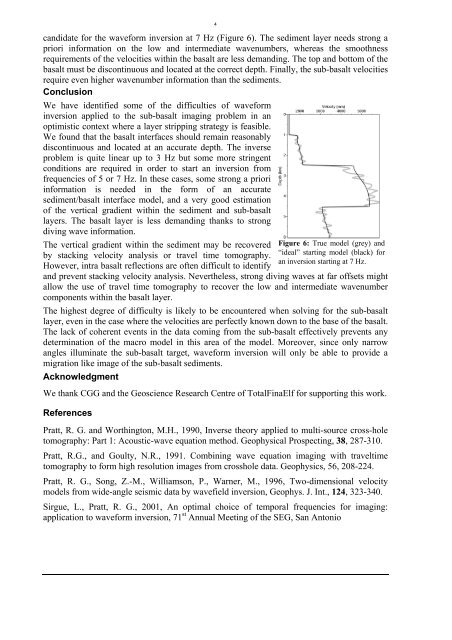p177 feasibility of full waveform inversion applied to sub ... - Earthdoc
p177 feasibility of full waveform inversion applied to sub ... - Earthdoc
p177 feasibility of full waveform inversion applied to sub ... - Earthdoc
Create successful ePaper yourself
Turn your PDF publications into a flip-book with our unique Google optimized e-Paper software.
4candidate for the <strong>waveform</strong> <strong>inversion</strong> at 7 Hz (Figure 6). The sediment layer needs strong apriori information on the low and intermediate wavenumbers, whereas the smoothnessrequirements <strong>of</strong> the velocities within the basalt are less demanding. The <strong>to</strong>p and bot<strong>to</strong>m <strong>of</strong> thebasalt must be discontinuous and located at the correct depth. Finally, the <strong>sub</strong>-basalt velocitiesrequire even higher wavenumber information than the sediments.ConclusionWe have identified some <strong>of</strong> the difficulties <strong>of</strong> <strong>waveform</strong><strong>inversion</strong> <strong>applied</strong> <strong>to</strong> the <strong>sub</strong>-basalt imaging problem in anoptimistic context where a layer stripping strategy is feasible.We found that the basalt interfaces should remain reasonablydiscontinuous and located at an accurate depth. The inverseproblem is quite linear up <strong>to</strong> 3 Hz but some more stringentconditions are required in order <strong>to</strong> start an <strong>inversion</strong> fromfrequencies <strong>of</strong> 5 or 7 Hz. In these cases, some strong a prioriinformation is needed in the form <strong>of</strong> an accuratesediment/basalt interface model, and a very good estimation<strong>of</strong> the vertical gradient within the sediment and <strong>sub</strong>-basaltlayers. The basalt layer is less demanding thanks <strong>to</strong> strongdiving wave information.The vertical gradient within the sediment may be recoveredby stacking velocity analysis or travel time <strong>to</strong>mography.However, intra basalt reflections are <strong>of</strong>ten difficult <strong>to</strong> identifyFigure 6: True model (grey) and“ideal” starting model (black) foran <strong>inversion</strong> starting at 7 Hz.and prevent stacking velocity analysis. Nevertheless, strong diving waves at far <strong>of</strong>fsets mightallow the use <strong>of</strong> travel time <strong>to</strong>mography <strong>to</strong> recover the low and intermediate wavenumbercomponents within the basalt layer.The highest degree <strong>of</strong> difficulty is likely <strong>to</strong> be encountered when solving for the <strong>sub</strong>-basaltlayer, even in the case where the velocities are perfectly known down <strong>to</strong> the base <strong>of</strong> the basalt.The lack <strong>of</strong> coherent events in the data coming from the <strong>sub</strong>-basalt effectively prevents anydetermination <strong>of</strong> the macro model in this area <strong>of</strong> the model. Moreover, since only narrowangles illuminate the <strong>sub</strong>-basalt target, <strong>waveform</strong> <strong>inversion</strong> will only be able <strong>to</strong> provide amigration like image <strong>of</strong> the <strong>sub</strong>-basalt sediments.AcknowledgmentWe thank CGG and the Geoscience Research Centre <strong>of</strong> TotalFinaElf for supporting this work.ReferencesPratt, R. G. and Worthing<strong>to</strong>n, M.H., 1990, Inverse theory <strong>applied</strong> <strong>to</strong> multi-source cross-hole<strong>to</strong>mography: Part 1: Acoustic-wave equation method. Geophysical Prospecting, 38, 287-310.Pratt, R.G., and Goulty, N.R., 1991. Combining wave equation imaging with traveltime<strong>to</strong>mography <strong>to</strong> form high resolution images from crosshole data. Geophysics, 56, 208-224.Pratt, R. G., Song, Z.-M., Williamson, P., Warner, M., 1996, Two-dimensional velocitymodels from wide-angle seismic data by wavefield <strong>inversion</strong>, Geophys. J. Int., 124, 323-340.Sirgue, L., Pratt, R. G., 2001, An optimal choice <strong>of</strong> temporal frequencies for imaging:application <strong>to</strong> <strong>waveform</strong> <strong>inversion</strong>, 71 st Annual Meeting <strong>of</strong> the SEG, San An<strong>to</strong>nio
















